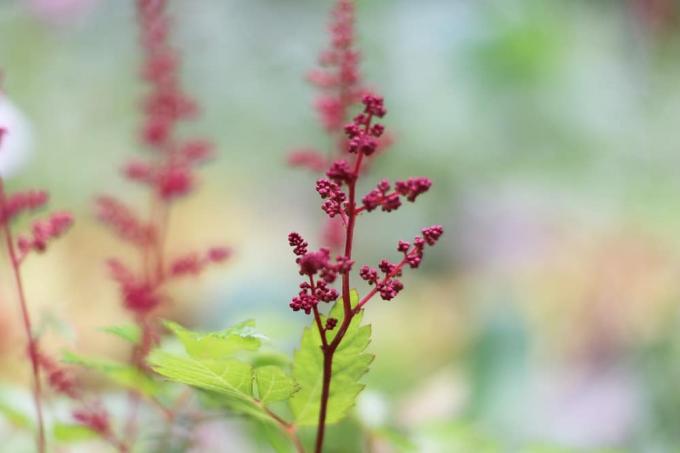
table of contents
- 7 most important location criteria
- Perennial for partial shade or shade
- Moist soil
- Ideal pH
- Nutrient-rich subsoil
- Soil poor in calcium
- Space requirement
- The right plant neighbors
- frequently asked Questions
Astilbes, also known as splendid sparrows, are perfect for partially shaded or even shady spots in the garden. The perennial, which comes from the damp forests of East Asia, blooms magnificently even in poor light, but certain conditions must be met for the optimal astilbe location.
In a nutshell
- If possible, plant in partial shade or shade
- especially avoid midday sun
- moist, nutrient-rich soil is essential
- the sunnier the astilbe location, the wetter the subsoil
- optimal pH value between 5.5 and 7.5
7 most important location criteria
The lush, mostly pink or purple flower stems of the astilbe only appear when the perennials are planted in a location that suits them. Set in the right place in the garden, splendid sparrows are extremely easy to care for. So that the plants feel good and you can enjoy the magnificent flowers, you should absolutely observe the following 7 criteria for an optimal astilbe location.
Perennial for partial shade or shade
Most flowering perennials need a location that is as sunny as possible. Not so with the astilbe, because their wild relatives grow in the twilight of the East Asian forests. You should therefore also use the plant in the garden

- offer as shady a place as possible
- Partial shade is also good
- provided that it is only sunny in the morning and / or evening hours
- Astilbes do not tolerate intense midday sun
- a partially shaded garden location is ideally well shaded around midday
In contrast, these perennials even thrive in particularly dark, north-facing places - in contrast to many other garden plants.
Note: A change of location makes sense if the perennials don't really want to bloom. Missing flowers are mostly the result of an unsuitable location, for example because it is too sunny or the soil is too dry.
Moist soil
The astilbe feels most comfortable when you plant it directly next to a stream or the garden pond. The plant needs fresh to moist soil; it does not tolerate dry, sandy subsoil. With regard to soil moisture, the rule applies that the sunnier the location, the more humid the earth must be. So it can be a little drier in dark planting areas. For exposed plantations such as stone or gravel gardens, however, you should prefer other types.

Ideal pH
If possible, plant splendid spar in a slightly acidic to pH-neutral soil. PH values between 5.5 and 7.5 are ideal for healthy growth and blooming. If necessary, you can improve the soil when planting with rhododendron soil or deciduous humus and thus lower a pH value that is too high.
Nutrient-rich subsoil
The ideal astilbe site also has a clay-rich, but loose and humus-rich soil. The perennials have a high need for nutrients and therefore do not get along well on poor subsoil.
Tip: Before planting, you can improve a poor soil with plenty of compost and thus ensure the supply of nutrients.
Soil poor in calcium
Since the astilbe needs a rather acidic pH value, lime is taboo. The garden soil should neither be calcareous, nor should you water the plants with calcareous water.

Tip: The latter is especially true for astilbe grown in planters or in a vase: Always make astilbe bouquets in rainwater or well stale and filtered tap water, pour Topfastilbene only with soft water Water. Otherwise you will not enjoy the beautiful flowers for long.
Space requirement
There are around 20 different species of astilbe, some of which can reach considerable heights of up to one meter and more. So that the plants have enough space to spread out and thrive, you should
- for high-growing varieties a planting distance of 40 to 60 centimeters
- in the case of varieties that remain lower, a planting distance of 20 to 25 centimeters

retain. If you want to cultivate the astilbe in a planter - for example on the balcony or terrace - it must be as wide and deep as possible. You should also water the plants regularly, because dry balls only put the perennials under stress and quickly causes them to die prematurely.
The right plant neighbors
If possible, only plant the astilbe together with species that have similar needs in terms of location and soil. Are ideal Rhododendrons and azaleas. Even Hostas (Hosta) and elven flowers (Epimedium) are suitable plant partners.
frequently asked Questions
Such an astilbe location is particularly useful for lower species such as the dwarf astilbe (Astilbe chinensis var. pumila) perfect. Over time, its runners form real carpets under trees and bushes. High-growing varieties, on the other hand, are more suitable for perennial beds.
We advise against cultivating the splendid spar in a sunny location. Even if the soil here is fresh or even moist, the plants will most likely dry up or dry out. at least suffer from unsightly dry damage such as brown leaves. You would also have to water regularly and a lot. Basically, the so-called Gartenastilben can withstand a little more sun, but these should also be planted in partial shade.
Put the splendid spar in as cool a place as possible, because too much heat dries out too quickly. The perennials are also very hardy and reliably sprout again every year, even after very cold winters. Winter protection is therefore not necessary, you can only leave last year's shoots and inflorescences. They are only cut off near the ground in spring.
